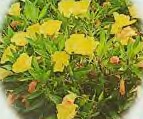






Perennial, Primula
Primrose is a hardy perennial flower, that includes a wide range of varieties. Primrose is native to Asia, Europe, and North America. In North America, they originally were found from the Midwest to the Northwest areas of the U.S.
There are many kinds of Primrose. From a gardener's viewpoint, they can be put into two groups: those that grow in bogs and woodlands, and those that thrive in rocky areas and on cliffs or hillsides. Some prefer rich, wet soils. While others like their soil dry. Most varieties grow from 8" - 15" tall.
Primrose come in a wide variety of colors, in single blooms or in clusters. Flowers are sweet smelling. Flowers bloom throughout the summer season. Plan on new plants blooming in the second year.
Primrose flowers attract Hummingbirds.
Primrose are excellent for hillsides and as ground covers.
Plant Height: 18" - 24"
Plant Propagation:
Primrose are grown from seed. Primrose plants do not transplant well. It is best to directly seed them into your flower garden, a hillside, or anywhere that you want to use them as ground cover.
Sow Primrose seeds early in the season and cover lightly with soil. Seed spacing varies by variety. Check the instructions on the seed packet. If information is not available, use 12" to 15" spacing as a gauge.
Day to Germination: 10 - 15

How to Grow Primrose Plants:
Primrose plants are easy to grow. They prefer cool weather, and full to partial sun. Soil conditions vary from rich loam to average soils, depending upon the variety. Mix in plenty of leaf mold prior to planting. Add leaf mold, if available, each year as a mulch, and to fertilize the plants. Drought tolerant varieties are very popular as ground cover in dry areas.
Once your Primrose plants are established, they will grow well and bloom all summer long with little or no attention. Anticipate the first blooms in the second year. Being very hardy, they will likely survive the first light frosts before going dormant for the winter. They do not require mulching or protection in the winter.
Flowers Bloom: Summer to early Fall
Insect and Disease:
Primrose are seldom bothered by insects and disease. If insect or disease problems occur, treat early with organic or chemical insect repellents and fungicide.
Copyright © www.100flowers.win Botanic Garden All Rights Reserved